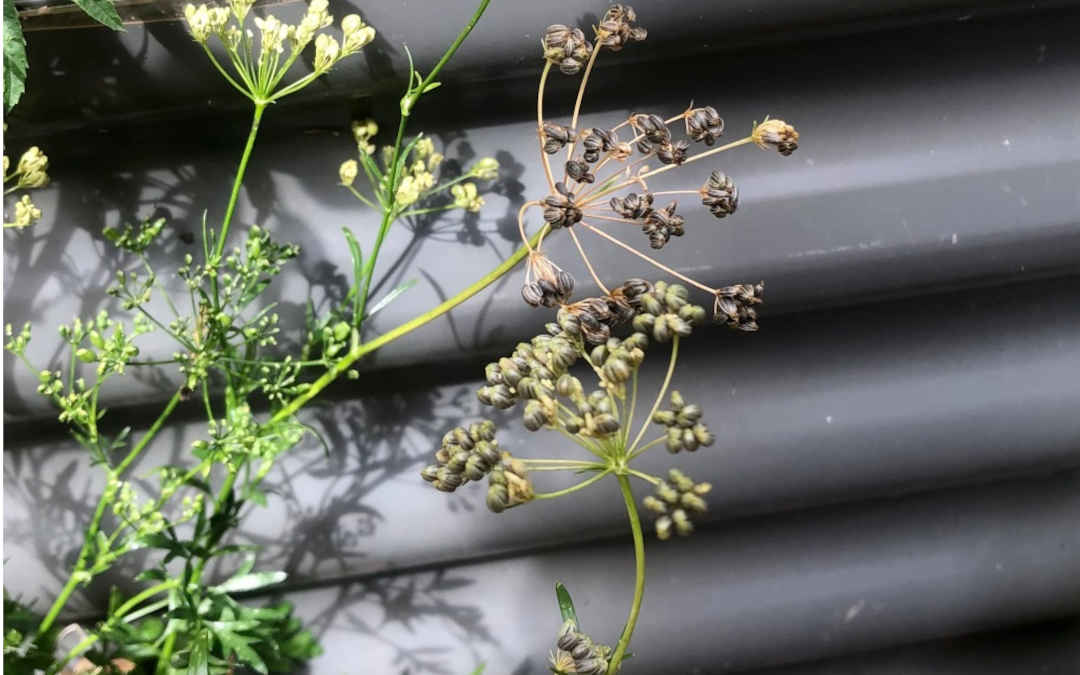It’s time to begin saving dry seed!

What is dry seed?
Dry seed is seed that forms on a stalk or in a pod as opposed to wet seed which forms inside a fruit such as a tomato or pumpkin or zucchini. It may be podless such as coriander or dill or lettuce or in a pod such as radish, peas or beans. Wait till the seed head looks quite dry – often brownish – before harvesting. Do not harvest when some or all of the seed is green. Lettuce seed heads will look like white, fluffy flowers. Deep inside will be white, black or brown seed.
How to process dry seed
Podless seed is easy to process. Choose a dry day to harvest and harvest only from dry plants. Simply cut the stems from the plant with secateurs. Do not pull or break stems or uproot the whole plant because this will result in much of the seed falling to the ground. Then place the seed heads in a bag (large paper shopping bags with string handles are ideal for this). Label the bag immediately. A plant you might easily identify in its prime in the ground, will change colour and leaf shape as it runs to seed, and may be difficult to identify when dry. Leave the bag in a warm, airy place for a few days then shake the seed heads or use your fingers to shred them which will loosen and remove the seeds, and they will fall into the bag. The fact that they fall tells you they are dried.
It is much the same process with podded seeds. If the seed pods are dried they will need to be cracked open either with your fingers or a rolling pin. If green, or not completely dried, as with peas or broad beans, for example, spread the pods in a single layer on wire (a window screen is ideal) and wait until the pods are brittle before removing the peas or beans from them.
The degree of moisture remaining in dry seed is an important consideration. Generally 5-8% is recommended, and adhered to commercially, but moisture content is impossible for home gardeners to measure. Each seed contains an embryo of the plant and if it was 100% dry this would kill the embryo. On the other hand, a seed that has too much moisture content will go mouldy and rot. The best we can do is to observe our seed to see that it is dry enough and then store it well in a dry, cool, airy place out of direct sunlight. I prefer to store dry seed in small brown paper envelopes as these will absorb small amounts of residual moisture. A glass jar on the other hand will not absorb moisture and if the seed is not dry enough, you may see condensation on the inside of the glass and this will lead to mould and rot.
The final step is to separate the seed from the chaff. I use a series of different sized mesh strainers and colanders first off. Sometimes the seeds fall through, sometimes depending on the size of the seed, the chaff falls through. Whatever I am left with after successive “sifts” will still contain some debris. If it is not much, I don’t worry about it – after all I’m not aiming to produce commercial seed and the debris will be a fine addition to my potting mix. I have two other methods for reducing debris. The first, is to blow gently upwards while the seed is in the strainer. The chaff will be lighter and blow away. The second is to fold a piece of A4 paper in half long ways, place some of the seed and chaff inside the fold with a bowl beneath the bottom of the paper, tilt the paper and blow upwards. As the chaff blows up and away, the seed rolls down into the bowl.
Useful links
Written by Robin Gale-Baker
